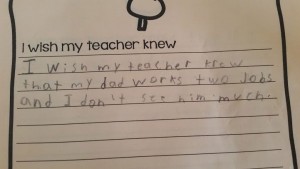This past unit I have learned how to create a lesson plan. While this is exciting it is also nerve wracking. This has made me reflect upon what I want to do in the future as an educator. I intend to use assessment techniques other than just tests. Some students do not perform well on tests and it is sometimes due to factors other than they didn’t study. Some student get anxiety from tests and this causes them to do poorly. By integrating papers and projects it will hopefully give students the opportunity to express the knowledge that they have in a way that is comfortable for them. According to an article I read about Backward Design the steps are 1) identify desired results 2) determine acceptable evidence 3) create the learning plans. This is different for me because when I think of designed a lesson I typically think of what activity or lecture I want to do and then think of what I want the outcome to be. However, Backward Design is helpful because when you already know what you want the outcome to be it makes designing the lesson a lot easier.
I designed my lesson using the Backward Design Framework. This was my first time ever actually creating a lesson plan and it was challenging for me. I decided to do an assessment based off of interaction and observation. The point of this lesson is to determine the child’s emotional development. This made things a little difficult because I could not plan out too many instructions to give to the students because I do not want them to act how they think they should in order to do well. However, using backward design I kept in mind that the end goal is to assess where this student is at in their emotional development. This made it easier to come up with an assessment because I already knew how I hoped the student would respond to certain situations. Therefore for part two I already had in mind the situations that the student needed to be put in. The reason I decided to create a lesson on emotional development is because I wanted to create a lesson about something that I might actually have to do in my future as a Special Education Teacher. Overall, I think Backward Design helped me organize my thoughts and create an effective lesson plan. Below you will see the lesson plan that I created.
STAGE 1 – DESIRED RESULTS |
|
| Unit Title: ____Emotional Development_______________
Established Goals: Students will show their ability to express a wide range of emotions and understands and responds to others’ emotions.
|
|
| Understandings: Students will understand that…• Students will understand how to use facial expressions and movements to express their emotions.
|
Essential Questions:• Do they know how to express their feelings?
-Are they able to use facial expressions or other body movements to express their feelings? -Do they use words and gestures to express complex emotions? -Do they show empathy for how others’ are feeling?
|
| Students will know:• How to display emotions such as pleasure, anxiety, surprise, anger, disgust, excitement, and disappointment.
|
Students will be able to:• Recognize the emotions of other people and respond in an appropriate way.
|
STAGE 2 – ASSESSMENT EVIDENCE |
|
| Performance Tasks:-The child will be put in a positive and a negative interaction to see how they react.
-A friend will pretend to have fallen and be hurt to see if the child reacts in an empathetic way.
|
Other Evidence:-The way the emotions will be gaged is through emotion charts. For example, after the student is put through a positive situation they will be asked to point to the smiley face that shows what they are feeling. They will be asked to do the same thing for the negative situation as well.
– If the child does not help their friend after they have been injured or if they walk away without showing any sign of sympathy, that will show they may not know how to recognize the emotions of other people or how to response appropriately. |
| Key Criteria:-The child should respond with smiling in the positive interaction and should show distress in the negative interaction as well as pointing to the smiley face that shows what they are feeling.
-The child should show comfort for their friend who is hurt and possibly offer to get them a band aid.
|
|
STAGE 3 – LEARNING PLAN |
| Summary of Learning Activities:
If the child does not respond in a way that shows their emotional development is where it should be the teacher needs to show them how they can improve. For example, teach them some coping mechanisms to handle stress or delight. This will teach them how to get their emotions out and express them more.
Ray, R. (2014, January 24). UbD Lesson Plan Template| Understanding By Design. Retrieved April 24, 2017, from http://www.storyboardthat.com/articles/e/what-is-ubd-understanding-by-design
|
